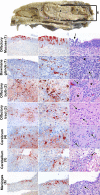The multibasic cleavage site in H5N1 virus is critical for systemic spread along the olfactory and hematogenous routes in ferrets
- PMID: 22278228
- PMCID: PMC3302532
- DOI: 10.1128/JVI.06828-11
The multibasic cleavage site in H5N1 virus is critical for systemic spread along the olfactory and hematogenous routes in ferrets
Abstract
The route by which highly pathogenic avian influenza (HPAI) H5N1 virus spreads systemically, including the central nervous system (CNS), is largely unknown in mammals. Especially, the olfactory route, which could be a route of entry into the CNS, has not been studied in detail. Although the multibasic cleavage site (MBCS) in the hemagglutinin (HA) of HPAI H5N1 viruses is a major determinant of systemic spread in poultry, the association between the MBCS and systemic spread in mammals is less clear. Here we determined the virus distribution of HPAI H5N1 virus in ferrets in time and space-including along the olfactory route-and the role of the MBCS in systemic replication. Intranasal inoculation with wild-type H5N1 virus revealed extensive replication in the olfactory mucosa, from which it spread to the olfactory bulb and the rest of the CNS, including the cerebrospinal fluid (CSF). Virus spread to the heart, liver, pancreas, and colon was also detected, indicating hematogenous spread. Ferrets inoculated intranasally with H5N1 virus lacking an MBCS demonstrated respiratory tract infection only. In conclusion, HPAI H5N1 virus can spread systemically via two different routes, olfactory and hematogenous, in ferrets. This systemic spread was dependent on the presence of the MBCS in HA.
Figures






References
-
- Aronsson F, Robertson B, Ljunggren HG, Kristensson K. 2003. Invasion and persistence of the neuroadapted influenza virus A/WSN/33 in the mouse olfactory system. Viral Immunol. 16:415–423 - PubMed
-
- Chen J, et al. 1998. Structure of the hemagglutinin precursor cleavage site, a determinant of influenza pathogenicity and the origin of the labile conformation. Cell 95:409–417 - PubMed
Publication types
MeSH terms
Substances
Grants and funding
LinkOut - more resources
Full Text Sources
Medical

